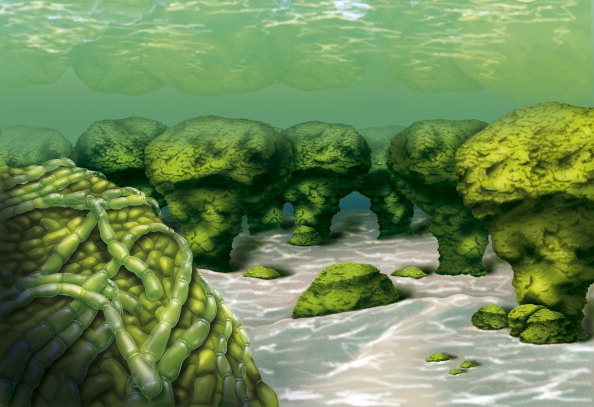
study |
Cyanobacteria and stromatolites. Illustration of a sea floor with stratolite, stony sedimentary structures made up of blue bacterial debris formed during oxygenic photosynthesis. Getty Images
An unprecedented abundance of ocean life demonstrated a crucial role in the creation of Earth’s first great mountains study It was led by scientists from the University of Aberdeen and published in the journal Communications Earth and Environment.
“Mountains are an essential part of the landscape, but large mountain ranges did not form until the middle of Earth’s history, about two billion years ago,” explains study author Professor John Parnell of the university’s School of Earth Sciences.
While the formation of mountains is generally associated with the collision of tectonic plates, which leads to the emergence of huge plates of rock, the study found that this phenomenon was caused by the abundance of nutrients in the oceans, which were two billion years old, which caused an explosion. of microscopic life.
The movement of tectonic plates probably began about 3.5 billion years ago, as mantle plumes pushed parts of the Earth’s crust back. But geological evidence in the form of belts of green stone indicates that only low-altitude mountains were formed in the first 1.5 billion years.
To allow tectonic plates to move and solid blocks of rock to slide over each other, thus forming higher mountain ranges, a lubricant is needed. Graphite, a carbonaceous mineral, can be used as a material. Graphite and graphite powders are valued in industrial applications for their self-lubricating and dry-lubricating properties. Life on Earth appeared at the same time as plate tectonics and is mainly based on carbon.
When the microorganisms that inhabited the first oceans of Earth died, they fell to the ocean floor. Their carbon-rich residue eventually formed graphite which played a crucial role in lubricating the fractured plate rocks, allowing them to pile on top of each other to form high mountains. The study found that the amount of life from plankton was unusually high about two billion years ago, creating the conditions for mountains to emerge for millions of years.
In Scotland, parts of the supercontinent that existed at the end of the Early Proterozoic (2.5 to 0.5 billion years ago) are exposed to the surface by erosion. Minerals formed under high pressure conditions, such as during mountain formation, found here indicate that basement rocks were once the roots of an ancient mountain range.
“The geological record of this period includes evidence of an abundance of organic matter in the oceans, which, when it died, was preserved as graphite in shale. While tectonic processes have long been known to have quenched, our research shows that the absolute abundance of carbon in the ocean It was they that played an important role in the thickening of the earth’s crust that built the chains.Earth’s mountains.We have evidence of this in northwest Scotland, where the roots of the ancient mountains and the slippery graphite that helped build them can still be found in places like Harris, Tiree and Gairloch,” summarizes Professor Parnell.
“Ultimately what our research showed was that the key to building mountains was life, which shows that land and the biosphere are inextricably linked in ways that were not previously understood.”
Dr Connor Brolly, study co-author from the University of Glasgow, said: “Buried graphite in the Earth’s crust is in great demand for future green technologies, for use in things like batteries, fuels and lithium-ion batteries. It is interesting to think of this two-billion-year-old event. , which was responsible for the formation of our natural world, now has the potential to play a major role in preserving it for future generations.”
Article translated from the American magazine Forbes – Author: David Bressan
<<< Read also: US: Infrastructure Bill a Triumph for the Environment? >>>

“Hardcore beer fanatic. Falls down a lot. Professional coffee fan. Music ninja.”






More Stories
SALES / PHOTO SALES – Nikon D850 “5 Star” Bare Body Photo Body at €2,539.00
Discovering a new turning point under the Antarctic ice sheet! What are the consequences?
Record number for an insect!